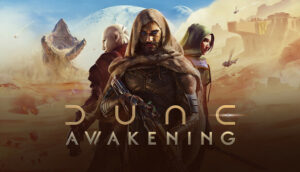Aeternum vs. Arrakis: Choosing Your Next Online Adventure (New World: Aeternum & Dune: Awakening Compared)
I. Introduction: The Shifting Sands of Online Worlds
The landscape of online gaming is in perpetual motion. Established virtual worlds evolve, seeking revitalization, while ambitious newcomers emerge, promising fresh experiences and leveraging powerful intellectual properties. We stand at an interesting crossroads, witnessing both the expansion of MMO-like experiences onto consoles and the adaptation of beloved universes into interactive formats. Two prominent examples capturing player attention are Amazon Games’ New World: Aeternum and Funcom’s Dune: Awakening.
New World: Aeternum (NWA) represents a significant relaunch and expansion of Amazon’s 2021 massively multiplayer online game. Timed with its debut on PlayStation 5 and Xbox Series X|S alongside its original PC platform, NWA aims to offer a refined experience, leaning into an “Action RPG” identity while retaining its MMO core. It seeks to draw in a wider audience, particularly console players, with promises of improved accessibility and content shaped by years of player feedback.
In contrast, Dune: Awakening (DA) plunges players into the harsh, iconic sci-fi universe created by Frank Herbert. Developed by Funcom, known for Conan Exiles, this title is positioned as an open-world survival game built for large-scale multiplayer interaction. Set on the treacherous desert planet Arrakis, it emphasizes brutal survival against the elements and colossal sandworms, resource control revolving around the coveted Spice, base building, and intricate political maneuvering between player factions. It too targets PC, PlayStation 5, and Xbox Series X|S.
This report aims to provide an honest, in-depth analysis of both New World: Aeternum and Dune: Awakening, drawing upon the latest available information from official announcements, developer insights, previews, and early gameplay feedback. By examining their core features, gameplay loops, intended audiences, and potential strengths and weaknesses, we will compare these distinct online adventures to help players navigate their choices and determine which world – the supernatural island of Aeternum or the deadly sands of Arrakis – best suits their preferences.
II. New World: Aeternum – Forging a New Destiny (Again?)
The Pitch: A Reimagined Aeternum
New World: Aeternum is not an entirely new game but rather a comprehensive overhaul, rebranding, and expansion of the original New World, strategically launched simultaneously on PC and consoles (PlayStation 5, Xbox Series X|S) on October 15, 2024. This release bundles the original base game, the Rise of the Angry Earth expansion, and all content updates and quality-of-life improvements introduced since the game’s initial 2021 debut, explicitly shaped by player feedback over the years. For existing PC players who own both the base game and the expansion, Aeternum functions as a free update, replacing the original New World title. Those owning only the base game need to purchase the Rise of the Angry Earth expansion to access the full Aeternum content.
A key aspect of this relaunch is a noticeable marketing shift, emphasizing the game as an “Action RPG”. While reviews and gameplay descriptions confirm it retains its core MMORPG structure with thousands of players sharing the world , this rebranding appears deliberate. Given the original New World‘s mixed reception and challenging launch period marked by long queues and technical issues , presenting Aeternum with a slightly different name and genre focus likely aims to attract a fresh audience, particularly on consoles, who may be unaware of or unburdened by the game’s history. The “Action RPG” label aligns well with the game’s dynamic combat system and the streamlined solo experience , potentially making it seem more approachable than a traditional, complex MMO, especially for controller-centric console players. The inclusion of full cross-platform play between PC, PS5, and Xbox Series X|S further broadens its potential player base.
Life on the Eternal Isle: Core Gameplay Loop
Gameplay in New World: Aeternum revolves around several interconnected pillars:
- Action Combat: The combat system is a defining feature, emphasizing real-time action rather than traditional tab-targeting. Players must actively dodge, block, manage stamina, and utilize light and heavy attacks alongside weapon-specific abilities on cooldowns. It’s a classless system; a player’s role is determined by the two weapons they choose to equip from a diverse arsenal including swords, axes, hammers, bows, muskets, magic gauntlets, and more. The Aeternum update brings significant enhancements for controller play, including optimized UI elements like radial menus, input presets, and crucially, a target-lock system. This lock-on feature makes combat feel more akin to console action games, though adjustments were made based on PvP feedback from the beta, such as making the lock break more easily with line-of-sight obstruction and reducing character turn speed while locked to improve evasion possibilities. Some weapons, like the Blunderbuss, received temporary PvP damage adjustments in response to feedback about guaranteed hits feeling unfair with target lock.
- Questing & Exploration: Players explore the large, visually distinct island of Aeternum, undertaking a mix of main storyline quests and numerous side activities. The original game faced criticism for repetitive quest design, often boiling down to “kill X enemies” or “loot Y chests”. Aeternum aims to address this with a fully revamped main story questline, enhanced dialogue presentation, in-game cinematics, and pre-rendered scenes designed to create a more engaging narrative experience. Reviews suggest this revamped storytelling is more coherent and engaging, making the world feel more manageable and approachable for new players. The leveling experience is generally considered smoother than at launch. Quality-of-life additions like swimming and mounts (horses, dire wolves, lions) also significantly improve traversal across the expansive island.
- Crafting & Gathering: New World features a deep and rewarding crafting system where players level up various trade skills—such as Weaponsmithing, Armoring, Engineering, Jewelcrafting, Arcana, Cooking, and Furnishing—simply by performing the actions. Gathering resources like wood, ore, fibers, and hides is integral to crafting powerful gear, consumables, and housing decorations. The system is often praised as one of the game’s best features, with crafted gear being competitive even at endgame. Aeternum introduces some simplification, making certain recipes easier to level up. A significant quality-of-life change removes the need for settlements to have specific tier crafting stations; crafting capability is now tied directly to the player’s skill level in that trade , reducing a previous point of friction.
- PvE Content: For group-oriented players, Aeternum offers Expeditions, which are 5-player instanced dungeons with unique mechanics and boss fights. The update introduces the game’s first 10-player raid, the Hive of the Gorgons, featuring challenging puzzles and boss encounters against Medusa’s brood. Additionally, repeatable endgame Soul Trials provide solo challenges against formidable foes for valuable rewards. Several older endgame activities, like the Sandwurm trial and certain Expeditions, have been upleveled to Level 70 with updated rewards to maintain relevance.
- PvP Content: Player-versus-player combat is a major focus. Players can flag for open-world PvP, engage in duels, or participate in structured modes. 3v3 Arenas now feature cross-world matchmaking and skill-based matchmaking for better quality matches. Outpost Rush is a 20v20 mode combining PvP combat with PvE objectives like capturing points and gathering resources. Territory Wars are large-scale, 50v50 siege battles where player companies fight for control over Aeternum’s settlements, offering significant strategic depth. A major addition in Aeternum is the Cursed Mists, a free-for-all PvPvE zone in Cutlass Keys where players compete to gather valuable resources and escape before being killed and looted by others.
What’s New & Improved in Aeternum?
New World: Aeternum consolidates years of updates and introduces several key features aimed at both revitalizing the experience for existing players and attracting newcomers, especially on consoles:
- Platform Expansion & Connectivity: Launch on PlayStation 5 and Xbox Series X|S alongside PC , enabled by full cross-platform play.
- Revamped Early Game: A completely overhauled starting experience and main storyline, featuring enhanced dialogue, cinematics, and a smoother progression curve. Introduction of Archetypes provides seven distinct starting playstyles (e.g., Destroyer, Mystic, Musketeer) to ease players into the classless system.
- Quality of Life & World Interaction: Addition of long-requested features like swimming and mounts with their own progression system.
- New Endgame Content: The Hive of the Gorgons 10-player raid , the Cursed Mists PvPvE zone , and repeatable solo Soul Trials.
- Console & Controller Focus: Enhanced controller support with features like target locking, radial menus, aim assist options, and UI adjustments. Performance optimizations aimed at smooth console play, including 4K and HDR support, and options for performance (targeting 60 FPS) or quality modes.
- System Updates: Maximum Gear Score increased to 725 , introduction of new powerful Artifact items , cross-world and skill-based matchmaking for PvP modes , and server technology enhancements (“Sharding”) to handle larger player populations and reduce queues.
The Verdict – Strengths & Weaknesses
Based on available information and early reviews, New World: Aeternum presents a compelling, albeit complex, picture:
Potential Strengths:
- Accessibility and Reach: The console launch and cross-play significantly broaden the game’s potential audience and inject new life into the servers. The buy-to-play model remains appealing compared to subscription MMOs.
- Improved Onboarding: The revamped starting experience, clearer storytelling, and smoother leveling curve make it much easier for new players to get into the game compared to its original launch.
- Engaging Core Systems: The action combat feels satisfying, particularly with controller enhancements. The crafting and gathering systems remain deep and rewarding.
- Visuals and Performance: Aeternum remains a visually striking world. Many reports indicate solid performance on consoles, particularly PS5, with smooth frame rates and fast loading times.
- Content Variety: Offers a diverse range of activities, including solo questing, group PvE (Expeditions, Raid), various scales of PvP, crafting, housing, and seasonal events.
Potential Weaknesses/Concerns:
- Legacy Issues: The game still carries the baggage of its original mixed reception, particularly concerns about endgame grind and repetitive content loops that plagued the initial release. Some players feel the new endgame additions (one raid, one PvP zone) might not be enough to sustain long-term interest for veterans.
- Cross-Progression Absence: The lack of cross-progression between PC and consoles is a major drawback. Players who invested heavily in the PC version cannot carry their progress to PS5 or Xbox, forcing them to choose a platform or start over completely. This decision feels counterintuitive to the unified “Aeternum” branding and creates significant friction for multi-platform owners, unlike some competitors who offer seamless progression. This could stem from technical limitations, platform policies, or a business decision to maximize revenue per platform, but regardless of the reason, it’s a point of frustration for players.
- Monetization Model: While buy-to-play is attractive, the $59.99 price tag , the requirement for original base game owners to purchase the Rise of the Angry Earth expansion for full Aeternum access , and the presence of a cash shop with cosmetics, including potentially expensive transmog tokens (reported at $5 each) , raise value concerns. Charging for transmogrification, a feature often included in base games or subscriptions, can feel like “nickel-and-diming” in a premium-priced title.
- Performance Variability: While many report good console performance, some reviews mention occasional frame rate dips, particularly in crowded areas, or find the visual quality a step down from high-end PC settings.
- Developer Track Record: Amazon Games has a limited history of sustaining MMOs long-term, leading to some skepticism about ongoing support and content cadence compared to more established developers.
III. Dune: Awakening – Surviving the Sands of Power
The Pitch: A Different Dune
Dune: Awakening emerges from the sands as an ambitious project from Funcom, the studio behind the successful survival game Conan Exiles. Positioned primarily as an open-world survival game infused with large-scale multiplayer elements, it deliberately steps away from traditional MMORPG conventions. Funcom has even clarified its marketing language, moving away from the potentially misleading “Survival MMO” tag to “open world, multiplayer survival game” to better set expectations. This shift underscores the game’s focus on core survival mechanics, sandbox freedom, and player interaction inspired by titles like Conan Exiles, rather than mimicking the quest-driven, level-focused structure of games like World of Warcraft.
The game is set on the perilous desert planet Arrakis, drawing heavily from Frank Herbert’s novels and the aesthetic of Denis Villeneuve’s recent film adaptations. However, it carves its own path with an intriguing alternate timeline: Paul Atreides was never born, Lady Jessica bore Duke Leto a daughter instead, and crucially, Duke Leto Atreides survived the Harkonnen assault on Arrakeen. This divergence creates a familiar yet fundamentally different political landscape where the Atreides and Harkonnen remain locked in brutal conflict over Spice, and the mysterious disappearance of the Fremen becomes a central plot point for the player to investigate.
Life on Arrakis: Core Gameplay Loop
Surviving and thriving on Arrakis in Dune: Awakening appears to be a multi-faceted challenge:
- Brutal Survival: This is the bedrock of the experience. Players must contend with three key threats identified by the developers :
- Water Scarcity: Arrakis is lethally arid. Players need to find shade to avoid the scorching sun, craft and maintain stillsuits to recycle bodily fluids, find rare water sources, or even extract water/blood from fallen enemies. Water is not just for drinking but also a vital crafting component. Sun exposure rapidly drains water and health, turning traversal into a tense exercise in finding shade.
- Shelter: Building bases is essential for protection against lethal sandstorms (Coriolis storms) and the relentless sun.
- Sandworms (Shai-Hulud): These colossal creatures are presented as unkillable environmental hazards. They are attracted to rhythmic vibrations on the sand, forcing players to move carefully, stick to rocky terrain, or utilize vehicles for faster, safer travel across open desert. Encountering one unprepared can mean losing all carried inventory permanently.
- Exploration & Traversal: Arrakis is described as a vast, open world filled with dangers and opportunities. Players can explore using iconic Dune tech like ornithopters for flight and suspensor belts for enhanced movement, alongside ground vehicles like sandbikes. A unique feature is the Deep Desert, an area dynamically reshaped each week by massive Coriolis storms, creating a race among players to explore newly revealed locations, resources, and dangers.
- Building & Crafting: Players can construct bases ranging from simple shelters to elaborate fortresses using a flexible building system. Crafting extends to gear (like stillsuits), weapons, vehicles (ornithopters), and furniture reflecting different faction styles (Atreides, Harkonnen). An interesting economic feature is the ability to turn completed base designs into blueprints that can be sold to other players via a server-wide Exchange, alongside harvested resources and crafted goods.
- Combat (“Combines Arms”): Combat involves a blend of approaches: melee weapons (crysknives, swords), ranged weapons (dart rifles, guns), vehicular combat (ground and air), and powerful abilities learned from the Great Schools of the Imperium (Bene Gesserit, Mentat, Swordmaster, etc.). Players can learn skills like the Bene Gesserit “Voice” to compel enemies. Third-person gunplay, based on beta impressions, feels functional and snappy for an MMO context but not revolutionary. Cooperation can enhance combat effectiveness, allowing players to combine different abilities strategically.
- Spice & Progression: Spice melange is the central resource, driving conflict and progression. Players hunt for Spice blooms, deploy harvesters, and must protect them from rivals. Spice can be traded, consumed to unlock powerful abilities and heightened senses , but may also come with drawbacks like dependency. Character progression involves honing crafting skills, mastering abilities from the Great Schools, acquiring better gear, and potentially aligning with major factions.
- Social & Political Systems: The game aims for a persistent world with significant social interaction. Players can visit bustling hubs like Arrakeen and Harko Village for trade and socializing. Forming guilds is encouraged. A key feature appears to be the server-wide political system, potentially involving a Landsraad council whose decisions impact all players. Players and guilds can swear allegiance to House Atreides or House Harkonnen, gaining unique rewards and participating in the larger conflict for control of Arrakis and its Spice. PvP is expected to revolve around resource competition (Spice, water), territory control, and factional warfare.
Unique Hooks & Features
Dune: Awakening seems poised to differentiate itself through several key elements deeply integrated with its source material:
- Deep Lore Integration: The alternate history premise, the presence of iconic factions, technologies (stillsuits, ornithopters), creatures (sandworms), and concepts (Spice, Bene Gesserit powers, Landsraad) promise an immersive Dune experience.
- Sandworms as Hazards: Making sandworms unkillable, ever-present threats that dictate movement and base placement is a bold design choice directly reflecting the lore. They serve as a constant source of tension rather than just another mob to fight.
- Dynamic World: The weekly Coriolis storms reshaping the Deep Desert offer “infinite exploration” potential and create regular opportunities for discovery and competition.
- Spice Mechanics: Treating Spice not just as a valuable commodity but as a consumable that grants power yet potentially fosters dependency adds a unique layer of resource management and risk/reward.
- Political Sandbox: The potential for server-wide politics via the Landsraad and the ability for guilds to align with Great Houses suggests a deeper layer of player-driven conflict and cooperation beyond simple faction PvP.
- Blueprint Economy: Allowing players to sell their base designs as blueprints could foster a unique player-driven economy and encourage specialization in building.
The Verdict – Strengths & Weaknesses
Based on previews and beta feedback, Dune: Awakening shows significant promise but also faces considerable challenges:
Potential Strengths:
- Powerful IP Appeal: The Dune universe holds immense appeal, and the commitment to capturing its atmosphere and lore, particularly the Villeneuve aesthetic, is a major draw.
- Unique Survival Gameplay: The survival mechanics tied directly to Arrakis’s harsh environment (water, heat, storms, worms) offer a potentially fresh take on the genre.
- Sandbox Freedom: The emphasis on base building, crafting, exploration, and player-driven politics offers significant freedom for emergent gameplay.
- Visual Fidelity: Powered by Unreal Engine 5, the game boasts impressive visuals, capturing the scale and desolation of Arrakis.
- Developer Experience: Funcom has proven experience in the online survival genre with Conan Exiles, suggesting a solid foundation for Awakening‘s systems.
- Monetization Approach: A buy-to-play base game ($49.99) with no mandatory subscription is attractive.
Potential Weaknesses/Concerns:
- Balancing Harshness: The very survival mechanics that make it unique could also make it overly punishing or tedious if not carefully balanced. Finding the sweet spot between challenging and frustrating will be crucial. This commitment to lore-driven difficulty is a double-edged sword; while authentic, features like extreme water scarcity or unkillable worms might alienate players seeking more conventional power progression or convenience.
- Technical Stability: Beta reports indicated significant bugs and performance issues, leading to a launch delay. A smooth launch is critical for a game of this complexity, especially given the history of survival game launches. Failure to deliver a polished experience could quickly derail momentum despite the strong IP.
- System Complexity: The interplay of survival, building, crafting, combat, Spice management, and political systems might prove overwhelming for some players.
- MMO Scale Uncertainty: While described as having large-scale multiplayer, the exact nature of server populations, player density, and the effectiveness of the “MMO elements” like the Landsraad remain to be seen in a live environment.
- Competition: The online survival market is crowded, requiring Awakening to truly stand out.
- Post-Launch Monetization: While the base game is buy-to-play, Funcom plans optional paid DLCs. The existence of Deluxe and Ultimate editions offering early access and season passes also introduces tiered purchasing, which sometimes draws player criticism. The specifics of cosmetic microtransactions are also yet to be fully detailed.
IV. Clash of Worlds: New World: Aeternum vs. Dune: Awakening
While both New World: Aeternum and Dune: Awakening are ambitious online multiplayer games targeting PC and consoles, they offer fundamentally different experiences rooted in distinct philosophies.
Setting the Stage: Core Identity
- NWA: An MMORPG with strong Action RPG elements, set on the supernatural, fantasy-themed island of Aeternum. Its focus is on dynamic combat, progressing through quests and structured group content (dungeons, raids), deep crafting, and organized PvP battles. It aims for broad appeal, enhanced by its console accessibility.
- DA: An Open World Survival game with significant multiplayer and sandbox components, set on the harsh sci-fi desert planet of Arrakis from the Dune saga. Its core is environmental survival, resource management (especially Spice), extensive base building, exploration, and emergent player-driven politics and conflict. It targets fans of the survival genre and the Dune IP.
Gameplay Philosophy & Core Loops
- NWA: Offers a more guided experience, particularly early on with its revamped main story. The core loop is familiar to MMO players: engage in action combat, complete quests or instanced PvE content (Expeditions, Raids), acquire loot and craft better gear to increase power, then participate in endgame activities like large-scale PvP (Outpost Rush, Territory Wars) or more challenging PvE. Skillful execution in combat is paramount.
- DA: Emphasizes emergent gameplay within a sandbox environment. The loop centers on immediate survival needs (water, shelter, avoiding worms), leading to exploration and scavenging for resources, which fuels crafting and base building. Acquiring and controlling Spice becomes crucial for power and influence, driving political maneuvering, factional conflict, and PvP encounters. Base expansion and consolidating influence are key long-term goals. Preparation, environmental awareness, and strategic player interaction are vital.
World & Atmosphere
- NWA: Features a lush, geographically diverse island with varied biomes, ancient ruins, and player-controlled settlements. The atmosphere is one of supernatural mystery and colonial-era fantasy, with magic and monstrous creatures being commonplace. While visually impressive, some criticism points to reused assets potentially diminishing the uniqueness of certain areas.
- DA: Presents a vast, desolate, yet beautiful desert planet. The atmosphere is defined by environmental hostility – the oppressive sun, blinding sandstorms, and the terrifying presence of sandworms create constant tension. The aesthetic aims to capture the specific sci-fi feel of the Dune books and Villeneuve’s films. The dynamic Coriolis storms add an element of unpredictable change.
Player Interaction (PvP & Cooperation)
- NWA: Features structured PvP systems. Players can opt-in to open-world PvP, fight in instanced 3v3 Arenas, battle in the 20v20 objective-based Outpost Rush, or participate in massive, scheduled 50v50 Territory Wars for settlement control. The new Cursed Mists zone adds a high-risk/reward free-for-all PvPvE experience. Cooperation is primarily focused on tackling Expeditions, the 10-player Raid, and achieving faction objectives in Wars or OPR.
- DA: PvP appears more integrated into the core survival and political loops. Conflict is likely to arise organically over scarce resources like Spice harvesters and water, control of territory (potentially involving base raiding), and through the formal factional conflict between Atreides and Harkonnen aligned guilds. Cooperation is essential for basic survival, defending bases, achieving guild ambitions, and navigating the server-wide political landscape (Landsraad). Sandworms can even be manipulated as weapons against other players.
Target Audience
- NWA: Appeals to players seeking an MMO experience with fast-paced action combat, those new to the genre (especially on consoles), individuals who enjoy structured PvE dungeons/raids and large-scale objective PvP, crafters, and fans of its specific supernatural fantasy setting. Survival elements are minimal.
- DA: Targets players who relish challenging survival gameplay (Conan Exiles, Ark, Rust), dedicated fans of the Dune universe, those who value sandbox freedom, intricate base building, player-driven politics, and emergent narratives. Requires tolerance for potentially harsh mechanics and a less guided experience.
Development & Business
- NWA: Developed by Amazon Games Orange County. The original game had a rocky launch but has received continuous updates and support, culminating in the Aeternum relaunch. Monetization involves a $59.99 buy-to-play price (including base game and expansion for new buyers), with existing base-game-only players needing to purchase the expansion, plus a cash shop for cosmetics.
- DA: Developed by Funcom, known for its expertise in the survival genre (Conan Exiles). Monetization includes a $49.99 base game price, planned optional paid DLCs, cosmetic microtransactions, and tiered editions (Deluxe $69.99, Ultimate $89.99) offering early access and season passes.
These contrasting approaches reflect divergent paths to player engagement. New World: Aeternum focuses on refining its action combat, delivering structured content updates like seasons, raids, and dungeons, and maximizing reach through console accessibility. Its engagement model relies on providing polished, repeatable activities within a familiar MMO framework. Dune: Awakening, conversely, bets on the depth of its interconnected systems – survival pressures forcing difficult choices and player interaction, intricate building and crafting, emergent political conflicts fueled by Spice control, dynamic world events like Coriolis storms, and the powerful draw of the Dune IP itself. Its success hinges on these systems creating compelling, player-driven stories and long-term investment within its demanding sandbox.
Table 1: Feature Comparison Summary
| Feature | New World: Aeternum | Dune: Awakening |
|---|---|---|
| Genre | Action RPG / MMORPG Hybrid | Open World Survival / Multiplayer Sandbox |
| Setting | Supernatural Fantasy Island (Aeternum) | Sci-Fi Desert Planet (Arrakis – Dune Universe, Alt-Timeline) |
| Combat | Real-time Action (Melee, Ranged, Magic), Skill-based | “Combines Arms” (Melee, Ranged, Vehicles, Abilities), Survival-focused |
| Core Loop | Questing, Combat, Crafting, Structured PvE/PvP | Survival, Exploration, Building, Resource Control (Spice), Politics |
| PvP Focus | Opt-in World PvP, Arenas, OPR (PvEvP), Territory Wars | Resource Conflict, Faction Warfare, Potential Base Raiding |
| Survival Elements | Minimal (Basic Consumables) | Core Mechanic (Water, Shelter, Sandworms, Storms) |
| Building | Player Housing (Cosmetic/Storage) | Extensive Base Building (Functional, Defensive), Blueprint System |
| Politics | Faction System (Territory Control via Wars) | Deep Potential (Landsraad, Guild Alliances, Faction Intrigue) |
| Monetization | Buy-to-Play ($59.99) + Expansions + Cosmetics (incl. Transmog) | Buy-to-Play ($49.99+) + DLCs + Cosmetics + Tiered Editions (Early Access) |
| Platforms | PC, PS5, Xbox Series X | S |
| Cross-Play | Yes | Planned (Implied by multi-platform release) |
| Cross-Progression | No | Unconfirmed (Likely No, based on Funcom precedent) |
V. Conclusion: Your Adventure Awaits
Choosing between New World: Aeternum and Dune: Awakening depends heavily on individual player preferences, as they cater to distinctly different tastes within the online multiplayer sphere.
New World: Aeternum emerges as a significantly refined and more accessible version of its former self. It offers a polished action combat system well-suited to controllers, a deep crafting loop, a variety of structured group activities for both PvE and PvP players, and a visually appealing fantasy world. The revamped onboarding experience and console launch make it an attractive proposition for newcomers or those seeking a more traditional, yet action-oriented, MMO-lite experience. However, potential players should be mindful of its past struggles with endgame longevity, the frustrating lack of cross-progression for PC veterans eyeing console play, and a monetization model that includes paid transmog on top of a premium price. It’s best suited for players who enjoy fantasy settings, action combat, crafting, and a mix of directed questing and organized group content.
Dune: Awakening presents an ambitious and potentially groundbreaking survival sandbox experience, leveraging the immense power of its source material. Its promise lies in deep, lore-driven survival mechanics, intricate base building with a player-driven economy, the potential for complex political maneuvering, and the sheer atmospheric tension of surviving Arrakis alongside (and against) hundreds of other players. The unkillable sandworms and dynamic Coriolis storms are particularly unique hooks. This game is tailored for enthusiasts of the survival genre who crave challenge and freedom, dedicated Dune fans eager to immerse themselves in an interactive Arrakis, and players who thrive on emergent gameplay and player-driven narratives. The primary caveats are the need for careful balancing of its harsh mechanics to avoid excessive frustration and the critical importance of a stable, polished launch, given the technical issues reported during beta testing.
Ultimately, the choice boils down to priorities:
- Choose New World: Aeternum if you seek a more accessible online action RPG experience with polished combat, strong crafting, structured group content (PvE and PvP), and a vibrant fantasy setting, particularly if playing on console.
- Choose Dune: Awakening if you desire a challenging, immersive survival sandbox deeply rooted in iconic sci-fi lore, offering extensive building, player politics, emergent gameplay, and the thrill of conquering (or being conquered by) a truly hostile environment.
Both titles represent significant undertakings in the online space. New World: Aeternum seeks a second wind through refinement and expansion, while Dune: Awakening aims to carve a unique niche by blending hardcore survival with the rich tapestry of Dune. Their long-term success will depend not just on their initial offerings, but on the developers’ commitment to ongoing content, community engagement, and technical stability. Your next great online adventure awaits – whether on the shores of Aeternum or the dunes of Arrakis is up to you.












Add comment